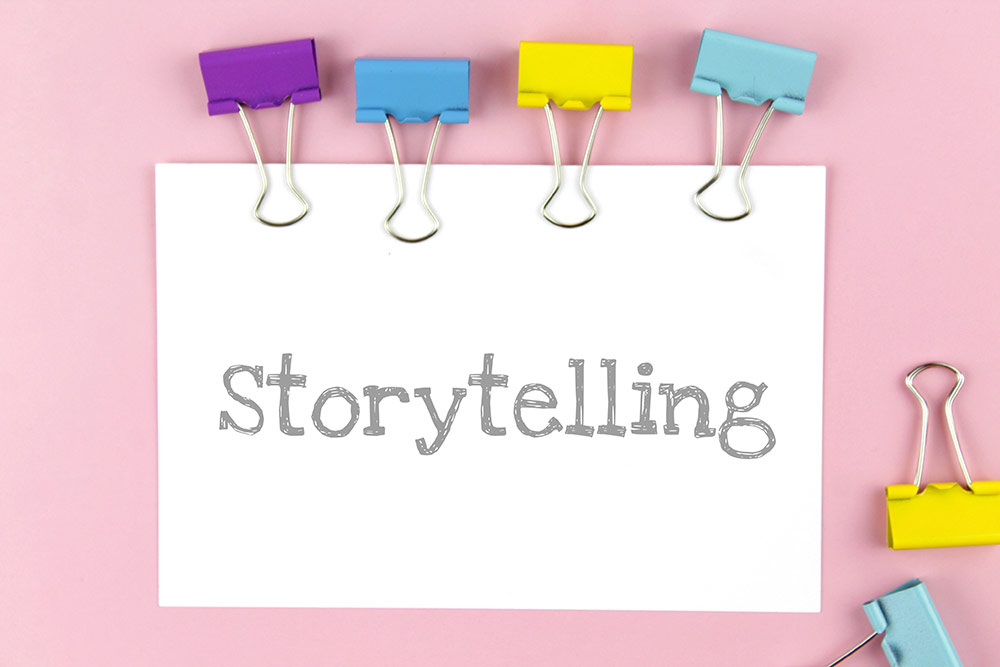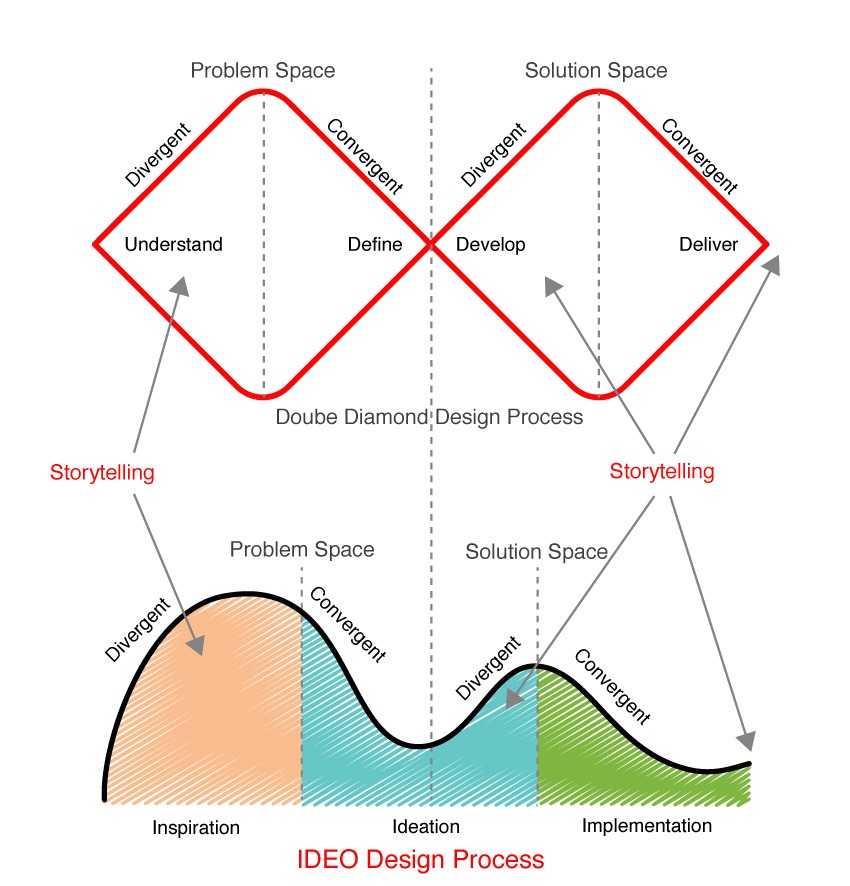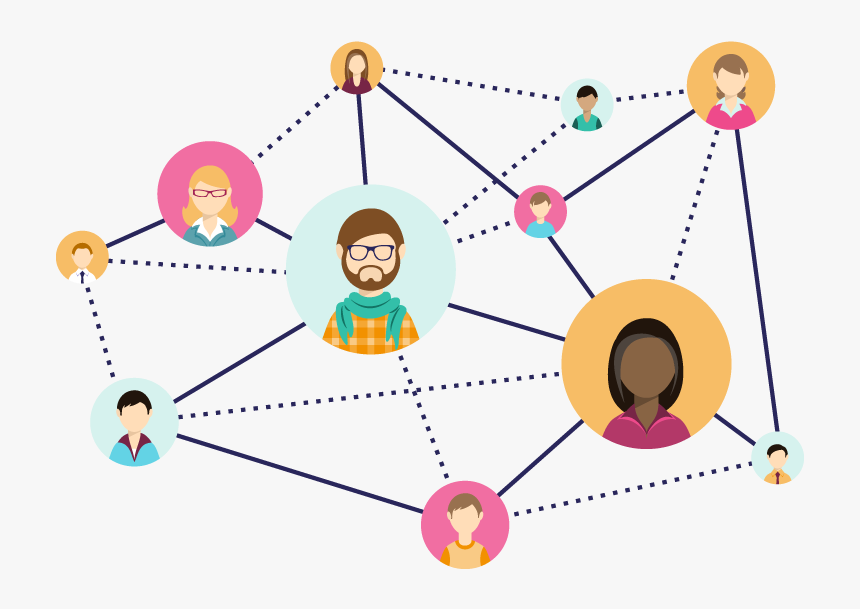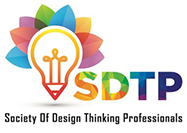“Storytelling is the most powerful way to put ideas into the world.” – Robert McKee.
Where there is a problem, there is the Design Thinking methodology to solve the problem. And where there are ideas and experiences, they are given verbal and visual shape through storytelling. Storytelling is a crucial human activity to explain values, share experiences and ideas, and reach a solution or solutions through expressing verbally and visually.
Storytelling explains the relations between people in various events and locations, while also teaching broad lessons to real people. People are more engaged when they are listening, and empathy is a necessary and fundamental component of the process.
Stories inspire questions, and questions broaden and deepen stories, resulting in a slew of new thoughts and ideas. Storytelling becomes a valuable technique for gathering input, which is the foundation of the iterative prototyping process that leads to solutions.
Stories and prototypes come together to explain and reposition events through a variety of possible interpretations, allowing researchers to try various ideas before committing exclusively to a service, program, or policy.
What is Storytelling in Design Thinking?

Design Thinking takes a methodical, disciplined, and objective approach to problem-solving. It clearly defines the challenge, provides multiple solutions, chooses one out of it, and executes it in the process. When a story blends with this process, it takes a narrative approach to efficiently remove the guesswork. Here, the design problem becomes the identification and delivery of a meaningful story into the minds of the users so they remember it, no matter what.
Why Do The Design Thinkers Need Storytelling?

When a design thinker identifies a problem as a narrative, there comes a question about the idea or meaning it is trying to convey. It is known as the controlling idea in the narrative term, which comes out to be the most challenging part. A complex idea must be distilled and refined into the simpler yet meaningful essence.
The sole intention of a storyteller is to make the users understand the process in the most interesting way possible. This moment reaches its climax at this point in a design story. So, a plot of multiple solutions to a single problem creates a better understanding of the narrative techniques.
What Are The Things To Consider In Storytelling?

When it comes to understanding the concept of storytelling, and how to implement it in the Design Thinking process, there is a need to venture into different parts of the process. It gives a clear picture of the scenario, and how to bring the pieces together to call it a story. However, every story contains the following components:
- What – It is the phase to define the problem that the story contains. It might be a user’s target like an online purchase refund, or booking an appointment in the Design Thinking process.
- Who – The characters in the story or those who are mentioned in the story. The main character represents the demographic data that will be utilized to create the persona that will be included in the design process. The user is the main character in this story since he or she is the one who has to deal with the events. Other characters may become involved, such as customer service representatives or staff who interact with the users.
- How – The three main phases of any story are the beginning, middle and end. There is a central crisis or difficulty in each storey, which usually occurs in the middle stage. This is usually the issue that is addressed during the design phase. However, there may be additional challenges or concerns that arise before the story’s main climax.
How To Use Storytelling In A Design Process?

As Design Thinking is a human-centric process, it makes sure that the user evolves at every stage of the process to provide a customized solution. That’s when storytelling comes into the picture at every stage with a different way of being implemented. In general, storytelling can be found in three segments: problem framing, solution framing, and solution implementation.
-
- Problem Framing
It is the phase that is used early in the process. The aim of it is to find the problem to create a proper understanding of the issue arising, that needs to be rectified. Here, the design thinkers can use storytelling in the explorative initiative. It engages the team with the user to define the challenge with the qualitative data accumulated from the research.
- Problem Framing
There can be multiple storytelling sessions with the users who match the persona characteristics well. On this basis, the data is collected and analyzed to create a general idea about the problem. The benefit of adopting the storytelling tool is that it aids in the creation of empathy for the problem by allowing customers to tell their tales and describe their pain points in the process. It aids in the creation of a “persona” empathy map of the customers’ sentiments and experiences.
2. Solution Framing
The design team would create many alternative ideas that need to be tested and assessed during the solution definition and prototyping stages to determine which is the best option from the user’s perspective. In this stage, storytelling can be used again, but with a different goal in mind. In this scenario, the team is attempting to determine which option is the most suitable for the customer.
In this stage of the design process, storytelling can be used to establish a two-way dialogue with the customer to validate the solution’s efficacy. Consumers can use the solution and provide feedback to the design team throughout the prototyping stage, therefore storytelling is even more important. The team will be able to see how customers interact with the prototype solution and develop a realistic grasp of the solutions proposed.
3. Solution Implementation
The ability to obtain user input on a product or service to enhance it in the future is one of the practical elements of the design thinking process. In this case, storytelling can be used to investigate how the final product is used in the actual world and how customers engage with it daily. The data gathered during the feedback sessions are typically used to improve future product versions.
While storytelling can be utilized at various stages of the design process, it is a good technique for gathering individualized experiences from customers. Because of the unique nature of each consumer’s experience, it may be difficult to create standardized data based on it, but this is one of the tool’s strengths.
It aids us in comprehending the empathetic experience that users have when interacting with a product or service. This distinct strength can be beneficial to the design thinking process, especially when it comes to addressing specialized challenges like medical procedures or individualized use cases.
Storytelling is a very powerful tool for Design Thinking Practitioners, and there are a few pillars to base your story:
- What is the name of your idea?
- Who is it for?
- What is the solution?
- What people need it?
- What evidence do you have?
- What are your next steps?
You have to go through these questions, and it will be easier for you to answer these questions because you have done empathy research in the process.
In the true spirits of design Thinking, there are two methods to construct your story:
1. EAD (Emotion, Action, and Detailing)
- Emotion: It is the way to observe the tone, body language, and behaviour of the user during the empathy stage.
- Action – It is where you perceive the emotions and provide a call-to-action accordingly.
- Detailing – It is where you combine the details of emotion and action phases to reach to an ultimate solution.
2. CAR (Challenge, Action, and Result)
- Challenge – It is all about the context. It is where you identify a challenging situation that needs to be solved.
- Action – It is where you decide to take the steps to achieve a positive end result.
- Result – It is the phase where you pull the strings together of all the gathered data and find a solution to the problem.
To sum it up, storytelling is a strong communication technique that allows us to learn more about our emotional experiences as human beings. As a result, it’s a useful tool to employ during the design process. It can be utilized at any point during the design thinking process, with each stage having a different aim. Other research approaches, such as surveys and consumer journey mapping, might make it difficult to get personalized emotive data about our customers’ experiences, but storytelling can do it better.
How To Connect With Users Through Stories?

The best way to use storytelling to share the research results with the users is by implementing an engaging way to create empathy. It helps to keep the design process user-centric and you can do it by:
1. Giving personas to your users
Personas contemplate a story about your insights that are based on user research. By defining the personas, you can visualize the experiences of your user and can gain insights into empathy. For example, Nisha, a 48-year-old corporate manager, is struggling to find a work-life balance. She barely takes off from her work, feels worn out and wants to steer her life in a different direction.
2. Creating a conflicting plot
To make the characters heroes and imagine how they may use your design to solve specific problems. Make this a storyboard or journey with each persona’s goal(s) established. For example,
Nisha comes to know about your app that manages time. Finding it useful in the current scenario, she downloads it and fills the questionnaire with the details about personal and professional life.
She is intrigued with the app and is using the app frequently. She lets it collect the information from her phone about handling the various tasks throughout the day.
In a week’s duration, your app schedules her activities and tasks, including her health and sleep data.
While scrolling through her phone, she finds time-management suggestions to be more productive while being well-rested.
The app has the option to continue or put a halt to the monitoring as well.
3. Giving the supporting role to the design
Demonstrate how it benefits your persona/life user’s and how simple it is to utilize. Consider how many steps Nisha must take to access your app and whether voice-activated items in her home might impact its recommendations.
4. Syncing with the setting
It is important to know when and where your users use the design to build empathy. For Nisha, it is workplace and home, it might be different for the people who work from home.
5. Providing a good look and feel
Appearance matters, regardless of how functional your design is. It is best to give a balance of colours, layout, and typography to your design. As a user, Nisha’s priorities regarding the design of the app are: it should be user-friendly with easy navigation.
Audiences are always captivated by good stories. Throughout the design process, you may utilize storytelling to ensure that all work is focused on the needs of the consumers and the value you want to provide them. You use your insights to tell a story about who your users are, what they need, and how you’ll give it after you’ve completed design research to understand their requirements and desires. This story allows everyone working on the project to perform empathy with the users and verify that their work is consistent with the story. As you’ve been telling a story throughout your project, marketing the design at the conclusion is simple because you already know which story to tell to demonstrate how your product adds value.
If you want to deep dive in the world of Design Thinking, then you can go to the links below:
https://www.amazon.in/Thinking-Playbook-Practitioners-Professionals-Publication/dp/1636333745/ref=sr_1_5?crid=1Z3X1ZYMG86J8&keywords=design+thinking+playbook&qid=1641439525&sprefix=design+thinking+playbook%2Caps%2C199&sr=8-5
https://notionpress.com/read/design-thinking-playbook-for-practitioners
Key Source:
https://thestorytelleragency.com/goodreads/50-best-quotes-for-storytelling
https://www.kindpng.com/picc/m/58-580504_connecting-people-png-7-png-image-cartoon.png
https://miro.medium.com/max/1400/1*nJodSvaB1snOmO2-MVE1zQ.png
https://miro.medium.com/max/1024/1*wmcRLcnQd7BnTfcbx5r9Gw.jpeg
https://www.designorate.com/wp-content/uploads/2018/09/storytelling-design-process.jpg
https://www.system-concepts.com/wp-content/uploads/2021/04/Week-1-Loop-image.png
https://elements.envato.com/photos/storytelling
Written by: Jimmy Jain & Afreen Fatima
Society of Design Thinking Professionals









